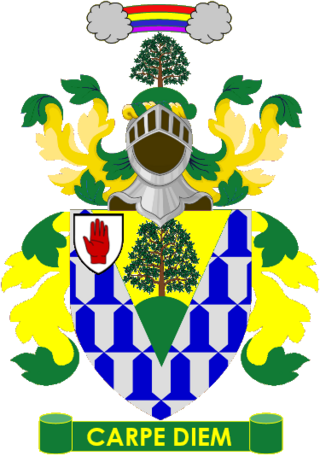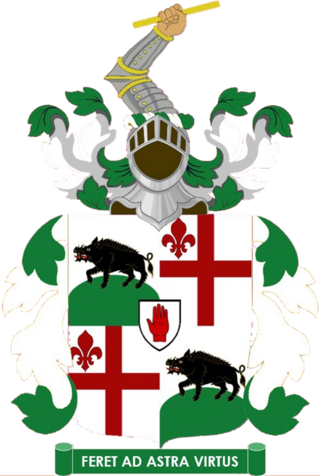There have been four baronetcies created for persons with the surname Leslie, one in the Baronetage of Nova Scotia, one in the Baronetage of Ireland, one in the Baronetage of Great Britain and one in the Baronetage of the United Kingdom. Three of the creations are extant as of 2010.
There have been ten baronetcies created for persons with the surname Mackenzie, seven in the Baronetage of Nova Scotia and three in the Baronetage of the United Kingdom. Four of the creations are extant as of 2010.

The Wigan Baronetcy, of Clare Lawn in Mortlake in the County of Surrey and Purland Chase in Ross in the County of Hereford, is a title in the Baronetage of the United Kingdom. It was created on 9 March 1898 for Frederick Wigan, a Director of the North London Railway. The presumed 6th Baronet, listed in Debrett's Peerage (2015) as the son of the 5th Baronet, has not successfully proven his succession and is consequently not on the Official Roll of the Baronetage.

The Chaytor family is an English gentry family on which has been conferred two baronetcies, one in the Baronetage of England and one in the Baronetage of the United Kingdom and several knighthoods. As of 2008 one baronetcy is extinct.

There have been four baronetcies created for persons with the surname Hope, three in the Baronetage of Nova Scotia and one in the Baronetage of the United Kingdom. As of 2010 one creation is extant, one dormant and two extinct.
There have been three baronetcies created for persons with the surname Noble, all in the Baronetage of the United Kingdom.
The Goulding Baronetcy, of Millicent in Clane in the County of Kildare and Roebuck Hill in Dundrum in the County of Dublin, is a title in the Baronetage of the United Kingdom. It was created on 22 August 1904 for the businessman William Goulding, a prominent freemason who was director several railway companies in Ireland, and son of William Goulding (1817–1884), the last Conservative MP for Cork City. He accompanied the Church of Ireland Archbishop of Dublin John Gregg and Bishop of Cashel Robert Miller "to see Michael Collins in May 1922, following the murders of thirteen Protestants in the Bandon valley, to ask whether the Protestant minority should stay on. Collins 'assured them that the government would maintain civil and religious liberty'."
There have been four baronetcies created for persons with the surname FitzGerald, one in the Baronetage of Ireland and three in the Baronetage of the United Kingdom.

There have been seven baronetcies created for persons with the surname Russell, three in the Baronetage of England and four in the Baronetage of the United Kingdom.

The Muir Baronetcy, of Deanston in the County of Perth and of Park Gardens in the City of Glasgow, is a title in the Baronetage of the United Kingdom. It was created on 20 October 1892 for John Muir, Lord Provost of Glasgow from 1889 to 1892. The second Baronet served as high sheriff of County Waterford in 1919. The third Baronet was a deputy lieutenant of Perthshire. As of 2007 the presumed fourth Baronet has not successfully proven his succession and is therefore not on the Official Roll of the Baronetage, with the baronetcy considered dormant. He has also chosen not to use his title.
The Meyrick Baronetcy, of Bush House in the parish of St Mary in the County of Pembroke and of Apley Castle in the parish of Wellington in the County of Salop, is a title in the Baronetage of the United Kingdom. It was created on 5 May 1880 for Thomas Meyrick, Conservative Member of Parliament for Pembroke from 1868 to 1874. Born Thomas Charlton, he had assumed by Royal licence the surname of Meyrick in lieu of his patronymic in 1858. As of 2007 the presumed fifth Baronet has not successfully proved his succession and is therefore not on the Official Roll of the Baronetage.

The Dilke Baronetcy, of Sloane Street in the County of Middlesex, is a title in the Baronetage of the United Kingdom. It was created on 22 January 1862 for the Liberal politician Wentworth Dilke. Apart from his political career, he played an important part in the international exhibititions in London in 1851 and 1862. Dilke was the son of the critic and writer on literature Charles Wentworth Dilke. He was succeeded by his son, the second Baronet. He was also a Liberal politician and served under William Ewart Gladstone as Parliamentary Under-Secretary of State for Foreign Affairs from 1880 to 1882 and as President of the Local Government Board from 1882 to 1885. However, his political career was effectively ended in 1885 after a well-publicised divorce case.

There have been three baronetcies created for persons with the surname Munro, one in the Baronetage of Nova Scotia and two in the Baronetage of the United Kingdom.
There have been four baronetcies created for persons with the surname O'Brien, one in the Baronetage of Ireland and three in the Baronetage of the United Kingdom.

The Kellett Baronetcy, of Lota in Cork, is a title in the Baronetage of the United Kingdom. It was created on 6 August 1801 for Sir Richard Kellett, with remainder to the heirs male of his father Richard Kellett. On the death of the second Baronet in 1886 the title passed to the third Baronet, a descendant of Henry Kellett, younger brother of the first Baronet. However, he did not assume the title until 1906. The presumed fifth and sixth Baronets did not successfully prove their succession and were not on the Official Roll of the Baronetage. The presumed seventh Baronet has also not successfully proven his succession and is not on the Official Roll of the Baronetage, with the baronetcy considered dormant since 1966.

The Leeds Baronetcy, of Croxton Park in the County of Cambridge, is a title in the Baronetage of the United Kingdom. It was created on 31 December 1812 for George Leeds. He was an equerry to Prince Augustus Frederick, Duke of Sussex. The Croxton Park estate in Cambridgeshire had been in the Leeds family since circa 1568. As of 2011 the presumed ninth and present Baronet, a resident of Canada, has not successfully proven his succession and is not on the Official Roll of the Baronetage.
Three Baronetcies have been created for persons with the surname Johnson: one of New York in 1755 in the Baronetage of Great Britain, and then one of Bath (1818) and one of Dublin (1909), both in the Baronetage of the United Kingdom. As of 2010 the Johnson baronetcy of Bath is dormant, and that of Dublin is extinct.

The Wombwell Baronetcy, of Wombwell in the County of York, is a title in the Baronetage of Great Britain. It was created on 26 August 1778 for George Wombwell, Chairman of the Honourable East India Company and Member of Parliament for Huntingdon. The fourth Baronet fought in the Crimean War and took part in the Charge of the Light Brigade and in 1861 served as High Sheriff of Yorkshire. As of 13 June 2007 the presumed seventh and present Baronet had not successfully proven his succession to the title, and is therefore not on the Official Roll of the Baronetage, with the baronetcy considered dormant since 1977.
There have been three baronetcies created for persons with the surname Maitland, two in the Baronetage of Nova Scotia and one in the Baronetage of the United Kingdom. Two of the creations are extant as of 2008 while the other is either dormant or extinct.

Sir Thomas Dawson Brodie, 1st Baronet of Idvies FRSE (1832–1896) was a Scottish lawyer and peer and progenitor of the Scottish law firm Brodies.















